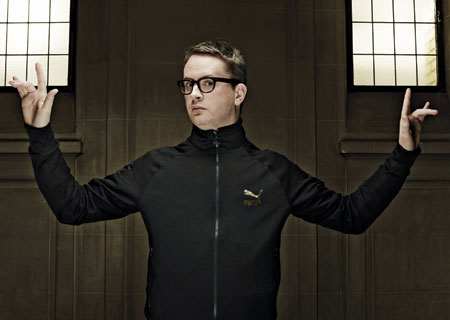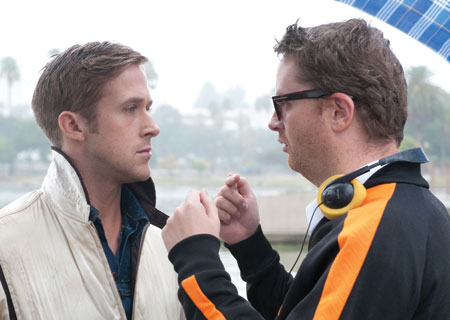By Scott Foundas
 NOT SO TOUGH: Contrary to public opinion, Refn says, “I’m not a violent person. I’m a very effeminate man.” (PHOTO: CORBIS)
NOT SO TOUGH: Contrary to public opinion, Refn says, “I’m not a violent person. I’m a very effeminate man.” (PHOTO: CORBIS) Ask a lot of directors about the movie that made them want to become a filmmaker and they will tell you Lawrence of Arabia or 2001: A Space Odyssey or Citizen Kane. For Drive director Nicolas Winding Refn, it was Tobe Hooper’s The Texas Chain Saw Massacre, seen at a revival screening at downtown New York’s venerable Cinema Village when the Danish-born, American-raised Refn was in his formative teenage years.
“I grew up in a cinema family,” says Refn, who is the son of a filmmaker father (Anders Refn) and cinematographer mother (Vibeke Winding). “My parents were brought up on the French New Wave. That was God to them, but to me it was the antichrist, and how better to rebel against your parents than by watching something your mother is going to hate, which were American horror movies. When I saw Texas Chain Saw Massacre, I realized: I don’t want to be a director, I don’t want to be a writer, I don’t want to be a producer, I don’t want to be a photographer, I don’t want to be an editor, I don’t want to be a sound man. I want to be all of them at once. And that film proved that you can do it because that movie is not a normal movie.”
Another influential viewing experience from around the same time, John Cassavetes’ The Killing of a Chinese Bookie, prompted Refn to enroll as an acting student at Cassavetes’ alma mater, the American Academy of Dramatic Arts in New York. But the anti-authoritarian Refn soon dropped out and returned to Europe, where he applied to the London and Danish film schools. Then, while working a summer job as a film scout for his uncle—a noted art house film distributor—Refn had an epiphany. In the market of the Cannes Film Festival, he happened upon a screening of Kevin Smith’s Clerks, a no-budget American independent film that had been making waves on the fest circuit. “My reaction was, ‘I can do that,’ ” he recalls. “And so I went home and I said, ‘Fuck it, I’m going to make a movie now.’ ”
The result was Pusher (1996), an industrious, low-budget crime drama about a mid-level Copenhagen drug dealer who runs afoul of a powerful Serbian drug lord. Refn’s goal was to make “a gangster film shot like The Battle of Algiers,” and to that end the director cast the film with a mix of professional actors (including the young Mads Mikkelsen) and real-life thugs. Shooting on the streets of Copenhagen with a handheld 16 mm camera gave the film a gritty, vérité look that is markedly different from the highly stylized visuals of Refn’s recent work (including Bronson and Drive).
Refn also took pains to shoot Pusher in chronological order—an unconventional method he has since employed on all of his subsequent features. “I read that Cassavetes had done it on some of his films, so I thought, ‘That’s a pretty cool approach,’” he says. “And after I did it on my first movie, I felt, ‘How can you do a movie any other way?’ It’s like a painting—you paint the movie as you go along, and I like the uncertainty of not knowing exactly how it’s going to turn out.”
Refn’s technique had already advanced considerably by the time of his second film, Bleeder (1999), a cross of sorts between Clerks and Reservoir Dogs about a circle of friends who hang out around a video store and spend much of their time watching lowbrow genre movies of the kind Refn gorged on in his youth. “It may be, personally, the film that I’m most attached to, because it’s a film about people who watch movies, but also a film about me figuring out what the medium is actually capable of. I didn’t want to be the guy who just made gangster movies,” Refn says.
Bleeder is also, explicitly, a film about the gulf between brutal everyday violence and stylized movie violence, as embodied by a father-to-be who feels emasculated by his increasingly domestic existence and seduced by the strong, silent tough guys he idolizes onscreen.
“Everybody asks me [about] this, which is kind of strange, because I’m not a violent person,” Refn says with a chuckle. “I don’t even do sports. I’m a very effeminate man, actually. But I think that art is an act of violence. Art is a flow of emotions and those emotions are basically created with a mixture of love and hate, lust and anger. It’s a contrast. And I think I’ve begun to realize that, in the end, I’m actually a pornographer, in that I make films about what arouses me.”
Before coming to that realization, however, Refn’s career took a nasty detour that nearly caused him to turn his back on filmmaking for good. “After Bleeder, I felt it was now time to make an important movie, one I would be remembered for, or a movie that is what a movie should be like,” he says. That movie turned out to be Fear X (2003), an existential, English-language thriller starring John Turturro as a Wisconsin security guard trying to solve the mystery of his wife’s murder by endlessly scrutinizing blurry surveillance videos of the crime scene. It was a critical and commercial disaster, leaving Refn—who had taken out a personal loan against the film when a financier dropped out in the eleventh hour—more than $1 million in debt.
 ACTOR'S DIRECTOR: Refn formed a close bond with Ryan Gosling on Drive, and is working
ACTOR'S DIRECTOR: Refn formed a close bond with Ryan Gosling on Drive, and is working
with him again on a remake of Logan’s Run. (PHOTO: KOBAL)After getting himself back on his feet with two Pusher sequels and a Miss Marple movie for television in England, he resolved “to try a completely different way of filmmaking than I was used to doing. I just thought, ‘What would turn me on? How do I get sexually excited in a film?’ ”
The answer was Bronson (2008), a biopic starring Tom Hardy as notorious British criminal-cum-artist Charles Bronson (né Michael Peterson) that became, in Refn’s hands, an immersion into the psyche of an ultra-violent man for whom all the world is quite literally a stage. In sharp contrast to the documentary influences that shaped Bleeder and the Pusher films, here Refn adopted a hyper-real aesthetic of long, carefully composed tracking shots and dramatically colored lighting effects.
Yet for all of his films’ pronounced formalism, Refn remains at heart an actor’s director who speaks lovingly of the bonds he has formed with his leading men (including Mikkelsen, Hardy, and Ryan Gosling, who stars in Drive and in Refn’s upcoming Only God Forgives). Like his preference for shooting chronologically, he eschews storyboards in favor of working the blocking out on the set with the actors, whom he expects to bring their own ideas about the movie and their characters to the table.
“I think the first thing I ask any actor is what they would like to do, which sometimes can frighten people or can be looked upon as, ‘Oh, you don’t know what you want,’ ” he says. “But I try to draw the actor in—to force them in, in some cases, because a lot of actors don’t want to discuss things or go in deep; they just want to come and do the work, play their part and walk away. But for me, it doesn’t work like that. You’ve got to get absorbed and dirty, and a way to do that is to ask the actor what they would like to do. It also forces them to be more truthful.”
Even once filming has begun, Refn likes to leave the door open to improvisation, inspiration, and enormous changes at the last minute—so much so that, recently, one of his foreign distributors asked him to please stop sending him his screenplays in advance, since his finished films bear so little resemblance to what was on the page. One of the most-discussed moments in Drive, for example—the scene in which Gosling’s mysterious Driver tenderly kisses his neighbor (Carey Mulligan) in an elevator, then abruptly bashes in the skull of one of the bad guys on their trail—was conceived of by the director mere days before it was shot.
“The story of Drive is not what makes it work,” Refn explains. “It’s the world and the characters that make the story work. But what was missing was what I call the heart of the movie. Every movie has to have a heart—a place where it defines itself—and in every movie I’ve made there’s always a scene that does that. On Drive, it was hard for me to wrap my head around it. I realized I needed to show in one situation that Driver is the hopelessly romantic knight, but he’s also completely psychotic and is willing to use any kind of violence to protect innocence. But that scene was never written. As I was going along, it just kind of popped up.”
When Refn won Best Director at the 2011 Cannes Film Festival for Drive, it seemed to cap his long comeback from the Fear X doldrums. Not surprisingly, Hollywood has since come calling, with an offer to direct Gosling in a big-budget reboot of Logan’s Run, the 1970s sci-fi opus about a futuristic world in which everyone dies at the age of 30. And while the road from art house auteurism to big-studio tentpole-building can be a rocky one, Refn is surprisingly sanguine about the prospects of getting to play with the proverbial “big toys.”
“I don’t really have an interest in making studio films,” he says. “I’m completely content with making the films I make now and with the releases that I get. But with Logan’s Run, I really want to make it. I’ve been obsessed with that movie since I was little—I collect old magazines about it. So I think doing Logan’s Run will be like having sex with the most expensive call girl in the world. Chances are it’s going to be fun and great—maybe a little empty. But in the end, it’s going to put me in a situation that I’ve never been in before, and that excites me. And so far, Warner Bros. has been very open to me saying I’m doing my version of Logan’s Run, which is very different from the previous versions. At the same time, if it ever was to go wrong, I’ve also got my own movie around the corner. So if I walk away, I walk away into something else.”